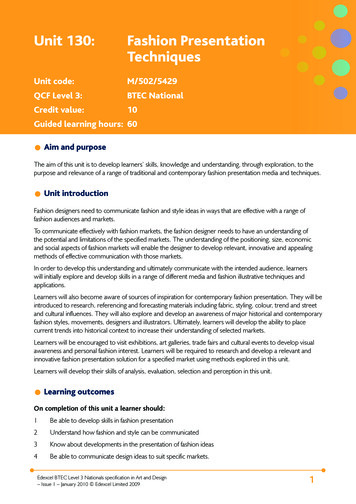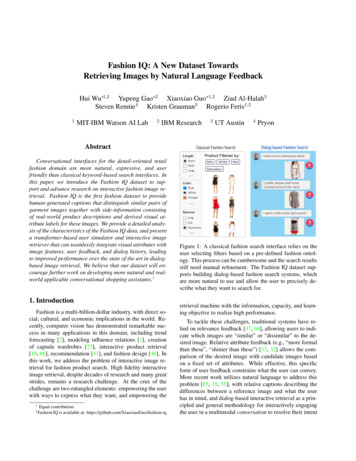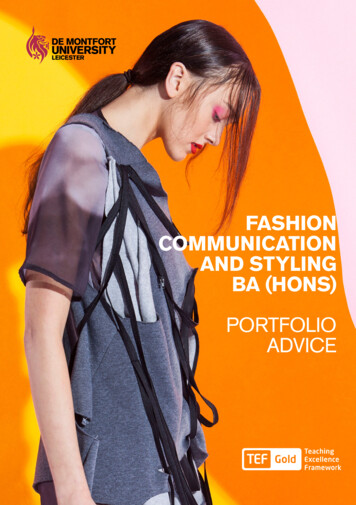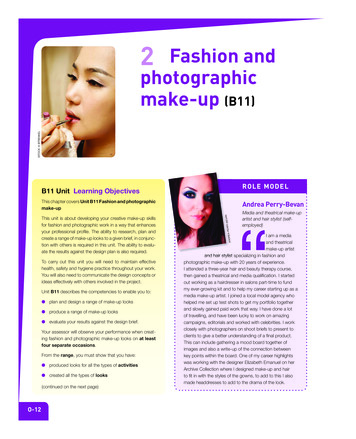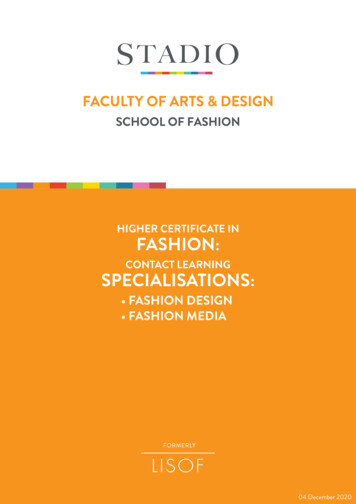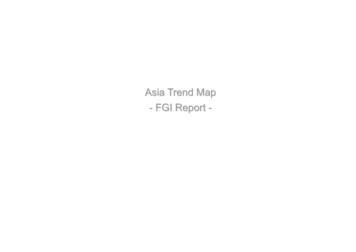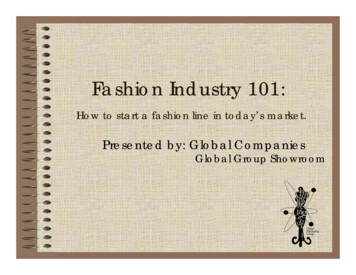
Transcription
CULTURAL DIFFERENCES INFASHION MAGAZINES– Targeting VogueThesis for Master, 30 ECTSTextile ManagementElin AlexanderssonRasha Matlak2017.15.12
AcknowledgementsWe want thank our supervisor Viveka Torell that has been very supportive and helpfulthroughout the thesis writing. Further, we would like to thank our opponents for theirrewarding comments.Elin Alexandersson & Rasha MatlakBorås, May 2017
Title: CULTURAL DIFFERENCES IN FASHION MAGAZINES – Targeting VoguePublication year: 2017Author: Elin Alexandersson / Rasha MatlakSupervisor: Viveka TorellAbstractThe purpose of this study is to examine how different cultures within clothing and fashion arefeatured in the magazine Vogues fashion reportages. The aim is to enlighten editors withinfashion media of these cultural differences in order to increase diversity. To pursue thepurpose of the study a qualitative approach was chosen where photographs were used as thedata that later on was studied through an image analysis. The study looks at six differenteditions of the fashion magazine Vogue, which indicates a chosen research design as multiplecase studies. The six Vogue editions are: US, Japan, Paris, Arabia, India and Brazil, in whichclothes, color and context have been analyzed in each editions reportages. The editions VogueUS, Vogue Japan, Vogue Paris, Vogue Arabia, Vogue India and Vogue Brazil reportages wasanalyzed and compared, and distinct cultural differences was seen in terms of color, culturalclothing and fashion contexts. While Vogue US, Vogue Japan and Vogue Brazil had a widerange in diversity regarding models with different appearance, which were light-skinned anddark-skinned, Vogue Arabia, Vogue India and Vogue Paris had not. Vogue Arabia, VogueIndia, Vogue US and Vogue Japan were however diverse in the cultural clothing, whereclothes that was shown in the reportages was a mix of different cultural clothes. Theresearchers therefore found Vogue US and Vogue Japan the most diverse.Keywords: Culture, Identity, Clothing, Fashion, Vogue, Diversity, Visual communication,Visual aesthetic, Fashion magazines, Cross-cultural.
Table of abia.29
onclusion.427.1Furtherresearch.43References.44
1. IntroductionThe outline for the introduction chapter will start with background for the chosen topic of thestudy, followed by problem discussion. Further, purpose and research questions of the studyare presented and lastly delimitations of the study.1.1 BackgroundThe world is today becoming smaller in terms of the amount of time it takes to moveinformation, people, goods, investment capital and fashion; it is an epoch of globalization(Jameson & Miyoshi 2003). The epoch of globalization is often described with the emergenceof capitalism, however, even before capitalism there was an exchange between Europe andAsia, Rome and India and among the Hellenistic empires that arose after Alexander the Great(Pieterse 1997). Hence, globalization is not recent; in fact, it’s a process with an immemorialorigin. The different conquest of Muslim and Mongols put large parts of the world in contact,as well as the western colonial imperialism (Jameson & Miyoshi 2003).In the 19th and 20th centuries we have seen the introduction of new technologies oftransportation: railroads, automobile, airplanes and above all; new technologies ofcommunication such as, photographs, telephones, movies, television, radio and satellitedelivery systems. They are all an ongoing process that led to the digital processing andInternet (Pieterse 1997). Communication across distances has never been faster and there hasnever been this much of it; it is in fact, the fast leap in our communicative resources, for everydimension of culture, that convinces us that there is an emergence of a different kind ofglobalization upon us, which creates the idea of one world (Jameson & Miyoshi 2003).The meaning of culture is something that can be described through different locations aroundthe world, which is influenced by collective and efforts of advertisers, producers, designers,rituals and consumers. The cultural meaning is therefore drawn from a culturally foundedworld and transferred to a consumer good; culture constitutes our world, by supplying us withit’s meaning (McCracken 1985).Our different cultural principles are however confirmed by human practices, different culturalprinciples are described as charter assumptions that allow all cultural phenomena, such asgoods, to be distinguished, ranked and interrelated (McCracken 1985). Goods confirm bothcategories and principles, which is why they enter the culturally constituted world as both theobject and objectification of this world. Goods become the creations and the creators of thecultural world. The goods of fashion system therefor invent cultural meaning, where itreshapes and reforms existing cultural meaning and encourages the reform of culturalcategories and principles (McCracken 1985).Fashion affects culture in visual ways. The global market is encouraged to change by moviesand television, which is why these technologies belong to the category of communicativemedia that are making the world a smaller place (Barnard 2014). Different types of artworkshave crossed cultural and ethnic boundaries for years, and since the audience and the artistshare similar assumptions about each other's expectation regarding the matter, they are able tohave a conversation. It can be described as having a “transnational conversation” between the1
artistic sender and the receivers who speak different languages and belong to differentcultures. When the artwork derives from different cultures, they stand side by side and are notart worlds apart. There are connections between galleries, museums, fashion magazines andexhibitions due to the explosion of communication (Meyer 2003).Some would say that fashion is a type of artwork, which is expressed in various ways. Others,such as Diana Vreeland, previous editor of both fashion magazine Vogue and Harper'sBazaar, has stated that fashion is not art (Barnard 2014). Though, there are those whodisagree, Martin (1999) states in the journal Fashion Theory that fashion and art have distinctsimilarities of impulses. What can be interpreted from different statements of what fashion isthere is not one but multiple issues in the definition of fashion. Style, emotions, culture, themind, expression, and spirit are some of the references that are drawn to understand fashion,and there is no doubt that fashion is a way for people to communicate in different ways, astheir identity, emotions and cultural associations (Barnard 2014).As fashion is a term with many definitions, the researchers of this study have chosen to definefashion in the same way as Barnard (2014) does above. This definition and reflection will bediscussed throughout the study when speaking of fashion. One of the areas, in which fashionis expressed, is through visual communication where different looks are portrayed accordingto specific cultures.1.2 Problem discussionCultural and national factors have seen to influence the content and the visual expression infashion magazines. It has been revealed that there are distinct differences in how differentpublishing countries of the fashion magazine Vogue present the content to the readers.Example of these differences that has been noted between UK, France and Russian editionsare the perception of what is truly feminine and masculine, and how the editions presentgender and sexuality (Kopnina 2007). The area of how different publishing countries presentthe content to the readers have however not further been explored.An issue related to communication and culture in general is the simplistic conclusions that aredrawn out from national and local standards, such as “images of the naked female body istaboo among the Muslim population”, and therefore might not be accepted in fashioncommunication. Further, the readerships polls of international fashion magazines, usually donot represent the average citizen but are usually western-oriented, socially liberated andrelatively economically well off (Kopnina 2007). This could indicate that simplisticconclusion about national and local standards needs to be taken with caution, and thatinternational fashion magazines could share visual expressions, which stretches over nationsand across cultures.Globalization is resulting in people coming into contact with other cultures and practices andpeople are in generally skeptical of that which does not apply to their standards. This in turnhas resulted in that people still have difficulty to accept and tolerate each other’s differences(Pike 2015). This takes it’s expression in the fashion industry, both internal and external,where criticism is given from the public for having marketing campaigns showing girls withveils (Rogers 2015; Khan 2015), but also public criticism of lacking cultural and ethnicaldiversity in fashion communication such as fashion shows and magazines (Fenwick Elliott,2015; Diamond, 2015; Pike, 2015). The contradiction, which this indicates, is a challenge for2
the industry and fashion communication could gain having the knowledge how to manage thisin a way so that people are more open and acceptant to each other's differences.The need of diversity in fashion communication is important in today's society because of theglobalization. Fashion dialogs create different versions of fashion in different cultures, but inorder to understand a national fashion culture more work needs to be conducted; work todescribe the global field of fashion (Diamond 2015). Fashion magazines are caught in anetwork of international relationships where the meanings they invest in fashion are built by astructure of national differences. These differences are parts of “the international struggle forthe domination in cultural matters” (Bourdieu 1999, p.171), a struggle that has its roots in thestruggle within each national camp, in a world where the dominant national definition andforeign definition are themselves involved (Bourdieu 1999).The luxury market is the least divers segment, which is reflected in fashion shows, campaignsand magazines (Pike 2015) where women of color are still clearly underrepresented(Diamond, 2015). Nevertheless, consumers who buy luxury fashion are more divers than everand that two of the fastest growing markets are the Middle East and Africa (Pike 2015).Hence, the luxury fashion segment would gain to communicate with a more diverse approach,which reflect the consumer segment better.1.3 PurposeThe purpose of this study is to examine how different cultures within clothing and fashion arefeatured in the magazine Vogues fashion reportages and how they reflect diversity. Our aim isthat editors within fashion media will be enlightened of cultural differences within clothingand fashion, in order to increase diversity in fashion magazines.1.4 Research questions1. How are different fashion cultures expressed by Vogue magazines fashion reportagesvarious signs?2. How do different editions of Vogue magazine reflect cultural diversity?1.5 DelimitationThe researchers will study fashion photographs, and the research is delimited to the Voguemagazines United States (US), Japan, Paris, Arabia, India and Brazil. The various editionswere chosen in accordance to cover distinctive fashion cultures from various geographicallocations in the world. Vogue US is located in North America, Vogue Japan in East Asia,Vogue Paris in Europe, Vogue Arabia in the Middle East and North Africa, Vogue India inSouth Asia and Vogue Brazil in South America. The photographs that will be analyzed in thedifferent issues are the photos portrayed in the magazines fashion reportages. The visualexpressions that will be analyzed when looking at Vogue reportages are the clothes, colorsand context, where context is in terms of background, models, body language, and facialexpressions. In addition to the visual expressions, the written statements, such as the meaningof the reportage will also be analyzed.3
2. Literature reviewIn the chapter literature review, a summary of chosen literature is given. In order tounderstand the meaning of fashion, which has been defined as a combination of style,emotions, culture, the mind, expressions and spirit, the researchers present definitions andreflections regarding culture, clothes and identity. Further, the researchers present differentfashion cultures in US, Japan, Paris, Arabia, India and Brazil. The literature gatheredconstitutes the literary framework for this study. In order to have relevant literature, theresearchers have used scientific articles but also other sources that the researchers haveconsidered valid and needed to obtain richness in the description of the different fashioncultures. This is due to the fact that research of certain cultures within fashion is a relativelynew researched topic.2.1 The relationship between culture, clothes and identityCulture can be defined in different ways; Emile Littre defined it as cultivation, which is themeaning to grow in terms of farming activity (Usunier & Lee 2013). The abstract meaning ofculture has its origins in the German language where the word “kultur” was used during theeighteenth century when referring to civilization. Today, Oxford English Dictionary definesculture as “the arts and other manifestations of human intellectual achievements” (OxfordDictionary, 2011). Another definition is “ the shared ideas, customs and social behavior of aparticular people or society” (Geertz 1973, p.12).We live in a world today that contains an ethnic, religious and linguistics puzzle; a worldwhere one of the toughest challenges of the modern societies is to respond to differentdemands that emerge from different cultural groups, where all attempt to protect their culturesand identities (Kymlicka 1996). Culture is described as the control mechanism of society. It isthe recipes, plans, rules and instruction of behavior; in fact, some would say that withoutculture people would have difficulty living together (Geertz 1973). Our cultural rules make itfeel as if our own cultural norms are naturally right and that other cultural norms are odd(Kluckhohn & Strodtbeck 1961)There is a strong link between culture and identity. It is said that culture creates identity andthat when thinking of identity, we immediately link it to language, ethnicity, religion andvarious symbols. When sharing a common language, faith or belonging to the same ethnicgroup it is said that people feel bound to each other (Constantin & Rautz 2010).The way we dress and our identity are intimately linked to each other. Clothes display, shapeand express identity while filling it with a direct material reality (Twigg 2007). Identity isdescribed as a process that develops through one's life span and is shaped during the stage ofadolescence (Kroger 1996). Further Cushman (1990) suggested that various things, such asconsumer products and advertising, affect one’s adolescence. Chaplin and Roedder (2005)conducted an investigation of the development of self-brand connection in children andadolescents, which showed that identity is intrinsically linked and even and can be defined by4
products in adolescence. The products that were described are many, and one of them wasclothing.Even though clothing is a basic human need, it is often interlinked to fashion. Fashion itselfcan be a confusing term, since it is a word that stands for the clothes of the designers,manufacturers, magazines etc. (Ribeiro 2003). Expressing yourself through fashion andclothes is a way of expressing your emotions, in the way that the body relates to cloth(Mouret 2003).From the time when sociologists, such as Veblen (1918) and Simmel (1904) studied themeaning of clothing, it was seen that clothing operates as a part of class identity (Veblen1918; Simmel 1904, see Twigg 2007, p. 2). Today clothing and fashion are moving down thesocial hierarchy and lower groups take up fashion. Class rivalry was however the engine offashion, where clothing was the marker of class distinction, where a dress was a proof ofcultural and capital establishment. The new form of fashion today is however seen in the riseof street style and the result that other aspects of identity are increasingly highlighted, such associal and cultural aspects (Davis 1992).2.1.1 Clothing as communication toolClothes and fashion work to communicate our identity and there is a relationship betweenthem, the link is representation; clothes represent identity. Representation means that onething stands for another thing, and in this case clothes stands for, or represent, one's identity(Barnard 2002). Our clothes can be described as the communication tool, which sends outinformation about our identity and both give and give off impressions (Goffman 1959). AsTwigg (2007) noted, Clothing mediates the relationship between the body and the socialworld, forming a tool that contain and makes the body, offering means whereby it isexperienced, presented and given meaning. Hence, what we wear stands for something aboutus, and that is a part of what clothing and fashion do. Further, one's personality or identity onthe inside can therefore be externalized with clothing so it appears on the outside (Barnard2002).McCracken (1988) discuss clothing and fashion as a metaphorical language, which lacks theability to communicate new messages. This means that what we wear can only communicatealready existing messages and if fashion tries to be “original” and used for the first timepeople will be confused and not understand what they see. Though, that fashion and clothingcould not be novel and original has been argued against, and the confusion about how themessages first come to existence is not explained (Barnard 2014). However, Campbell (1997)points out that a message that is spoken through clothes also needs to be of a known languageto the receiver, in order to be understood correctly. This means that clothing can havedifferent meaning to people depending on who sees it, and between some people thecommunication will work successfully and be understood correctly, while others mightunderstand the intended message all wrong. Further, Campbell (1997) states that successfulcommunication through clothes will be founded in the shared values and knowledge betweenpeople.5
2.1.2 Shared meanings and interpretation of clothing creates culturalgroupsThe meaning of clothing and fashion vary to people depending on different beliefs and values.People, who share the same or similar beliefs and values as other people, can understand thesame meaning of what clothing and fashion can convey. Hence, understanding the samemeaning of clothes is one of the conditions to belong to the same cultural group, and to sharethe understanding of clothes and why it is worn is therefore fundamental. Thus, this givespeople an identity (Barnard 2014).The same piece of clothing can be interpreted differently depending on identity and culturalbackground. A blouse can generate different meanings between different cultural groups, butalso be interpreted differently. The background knowledge of the blouse is important, andknowing who the designer is and what the blouse might represent will for some make theinterpretation of the blouse in one way, while some might interpret the blouse in a totaldifferent way (Campbell 2007). The relation of the values to the same blouse can thereforegenerate different meanings, and it is the process of the expression and interpretation thatgenerates the membership of different cultural groups. Hence, identity is to know andunderstand the meaning of the performance and the clothing is a part of that performance.Identity can therefore be seen as a product of knowing and understanding the meanings of theprocess of expressions and interpretations, as the meanings are the product of values thatpeople of different cultural groups hold (Barnard 2014).2.2 Different fashion culturesIn this section of the literature review the chosen fashion cultures are presented; US, Japan,Paris, Arabia, India and Brazil. Paris stands instead of France as the edition of the Voguemagazine has the name Paris and not France as the country, whereas Arabia stands for theGulf-states and the Middle-east/North Africa (MENA)-region.2.2.1 USWhen analyzing the American dress culture, it is clearly seen that different elements hasinfluenced fashion. Class, race, gender, politics, sport, war, business, popular music andmovies are some elements that have influenced how women in America dress (Welters &Cunningham 2005).Political movements that started in the 1960s have influenced fashion. Liberated womendemonstrated against the normative gender roles, and the clothing during this time in Americastretched beyond clothing and became a way to express political statements. People dressed inliberated and comfortable clothing and rejected on the stereotyped dress codes. Womenstarted to wear clothing that men used to wear and the blue jeans and T-shirt became anessential for every-day use (Luther Hillman 2015). Blue jeans were celebrated for its comfortand utility, and as the jeans became fashion, it was also an anti-fashion symbol during thetime of anti-consumption movements (Salazar 2010), and so was the T-shirt. The T-shirt wasoriginally used as an undergarment for men in the 19th century and became a symbol for6
America and individualism during the World War II. Now the T-shirt was not only used asunderwear, but also solely as outerwear (Neal 2014). Sportswear has been influenced theAmerican fashion as well, and comfort, relaxed and functional cuts became to influencefashion with help from Hollywood (Welters & Cunningham 2005).The leisure wears and the hippie era, which had previously influenced the US fashion,
dark-skinned, Vogue Arabia, Vogue India and Vogue Paris had not. Vogue Arabia, Vogue India, Vogue US and Vogue Japan were however diverse in the cultural clothing, where clothes that was shown in the reportages was a mix of different cultural clothes. The researchers therefore found Vogue
